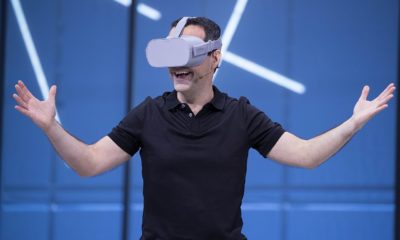Business
Three ways companies can leverage VR to innovate during a pandemic
Although the current crisis turned life upside down, it pushed companies to turn to VR for modern solutions. Professionals can expect to see even more businesses leverage VR in 2021 as they explore new spaces, train their employees, and offer something new and exciting for everyone. The pandemic hit the travel industry hard, but VR presents industry professionals with another option.

Even before the pandemic, virtual reality was a burgeoning sector. In 2018, a report from ARtillery Intelligence predicted the industry could reach $14.8 billion in revenue by 2023. Another report from the following year echoed this sentiment, forecasting that 23.5 million jobs would leverage VR for training, customer service, and virtual meetings by 2030.
Now that the pandemic has accelerated digital transformation in all industries and business areas, these growth predictions feel conservative. Virtual reality, which was considered too futuristic only a few years ago, is now viewed as perfectly suitable for solving pandemic-era problems. It might seem like VR has come a long way, but there are still plenty of opportunities for innovation.
Putting VR to work
Due to social distancing and quarantine restrictions, traveling wasn’t an option for many professionals throughout the pandemic. As a result, many people turned to VR to help them meet others in a safe environment.
For example, Spatial — a company that turns photos into holographic avatars that can collaborate in virtual workspaces — experienced a 1,000% increase in users after lockdowns began in March 2020. Meanwhile, a company called Argodesign invented the Square, a screen that uses multiple cameras to produce 3D images of people.
This brings us to the essential question behind virtual reality: What’s possible? The only limitation to VR is our imaginations. Reorganizing a factory floor or process without disrupting operations is impossible in the real world, for instance, but VEERUM’s platform lets customers visualize changes to spaces in an unaffected environment.
Although the pandemic has altered many aspects of daily life, it has opened up a virtual world of opportunities. Here are three ways companies are strategically using VR:
1. Virtual tourism
The pandemic hit the travel industry hard, but VR presents industry professionals with another option. When it’s not safe or advisable to travel nationally or internally, agents can help people take a virtual honeymoon to Hawaii with 360-degree VR. Digital experiences like this won’t replace the exhilaration of seeing a new place for the first time in person, but they can certainly inspire future visits and introduce travelers to potential destinations. Businesses in other industries can use a similar technique by allowing customers, prospective employees, or even investors to visit their offices and work sites virtually.
2. Immersive training
VR training lets employees learn and make mistakes without endangering others or damaging expensive equipment. In 2019, Boeing (NYSE: BA) used the technology to teach mechanics how to build and maintain its 737 MAX 10 airplane. This helped teams learn what to do and how to do it months before the equipment arrived.
Meanwhile, the U.S. Air Force used VR to create a realistic suicide prevention training program in 2020, enabling participants to train under the pressure of a real-life scenario without putting lives at risk. Other businesses can use this technology similarly to turn their training programs into safe, practical simulations.
3. Virtual experiences
Virtual experiences exploded into the mainstream when musician Travis Scott partnered with Epic Games to perform a virtual concert in “Fortnite.” However, these experiences can be more than just entertainment.
For instance, what if Salesforce (NYSE: CRM) hadn’t livestreamed its 2020 World Tour Syndey event and instead turned it into an online venue? Thousands of professionals could have explored the online space and attended panels virtually. Moving forward, companies should consider what events and conferences they can create for consumers, employees, and partners.
Although the current crisis turned life upside down, it pushed companies to turn to VR for modern solutions. Professionals can expect to see even more businesses adopt VR in 2021 as they explore new spaces, train their employees, and offer something new and exciting for everyone.
—
(Featured image by FunkyFocus via Pixabay)
DISCLAIMER: This article was written by a third party contributor and does not reflect the opinion of Born2Invest, its management, staff or its associates. Please review our disclaimer for more information.
This article may include forward-looking statements. These forward-looking statements generally are identified by the words “believe,” “project,” “estimate,” “become,” “plan,” “will,” and similar expressions. These forward-looking statements involve known and unknown risks as well as uncertainties, including those discussed in the following cautionary statements and elsewhere in this article and on this site. Although the Company may believe that its expectations are based on reasonable assumptions, the actual results that the Company may achieve may differ materially from any forward-looking statements, which reflect the opinions of the management of the Company only as of the date hereof. Additionally, please make sure to read these important disclosures.

-

 Impact Investing1 week ago
Impact Investing1 week agoEU Expands Leadership in Sustainable Finance with Record Green Bond Impact
-

 Impact Investing5 days ago
Impact Investing5 days agoEU End-of-Life Vehicles Rule Pushes Cars Toward a Circular Economy
-

 Crowdfunding2 weeks ago
Crowdfunding2 weeks agoFlower Burger Launches Crowdfunding to Fuel Growth in Booming Plant-Based Market
-

 Business2 days ago
Business2 days agoTopRanked.io Weekly Affiliate Digest: What’s Hot in Affiliate Marketing [1xBet + FIFA World Cup]
























